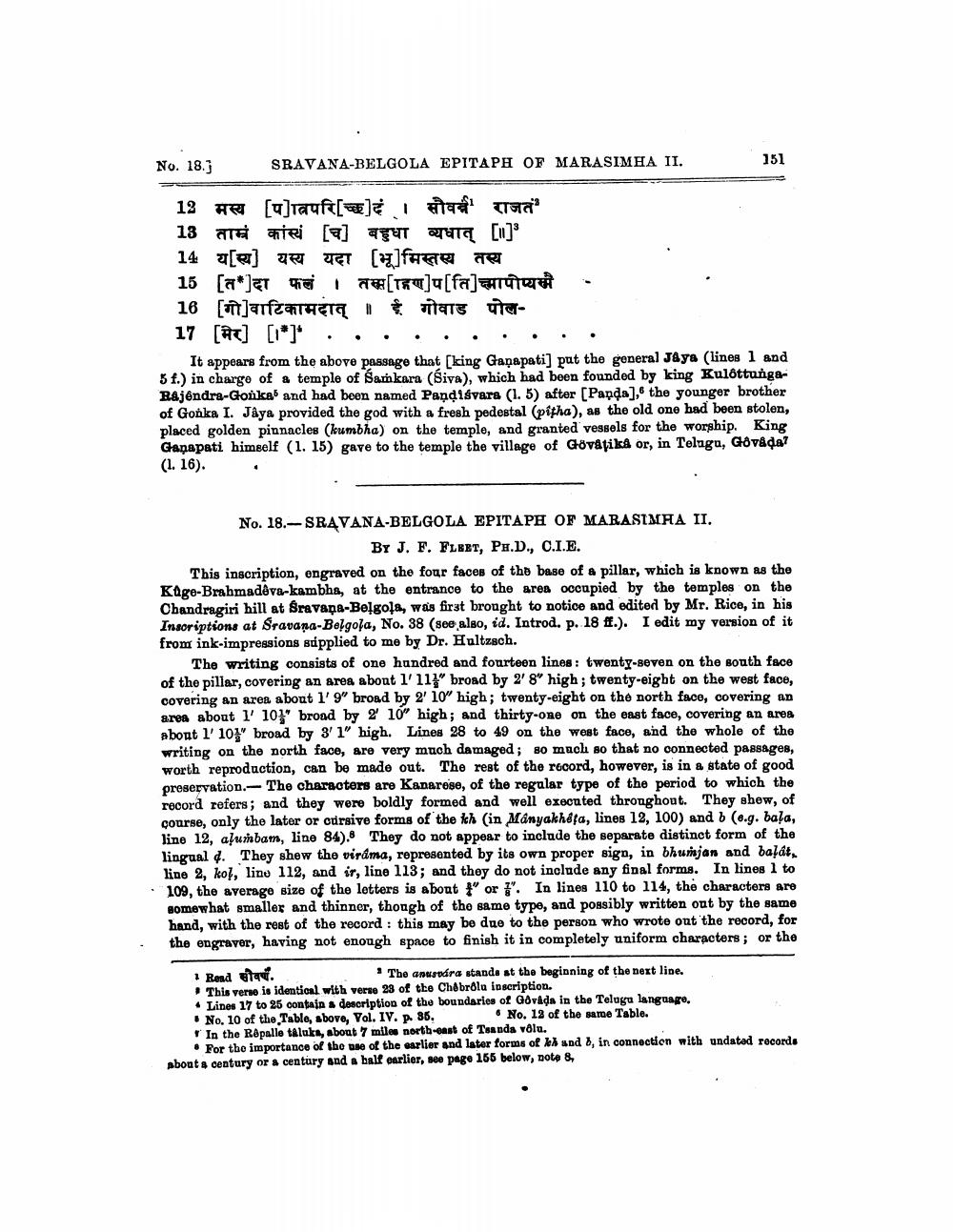________________
No. 18.3
SRAVANA-BELGOLA EPITAPH OF MARASIMHA II.
151
12 # [C]rauft[ ] i
rad 13 ore Hiei [] afy q [1]* 14 d[e] JRUCT [w]fuge Te 15 [a*]ET I [15 ]u[fa] namu . 16 [5]aiftarhero
ate 17 [#] [1*]* . . . . . . . . . .
It appears from the above Passage that sking Ganapati] put the general J&ya (lines 1 and 5 f.) in charge of & temple of Samkara (Siya), which had been founded by king KulôttungaRajendra-Gonka and had been named Paņdiśvara (1. 5) after [Panda], the younger brother of Gonka I. Jaya provided the god with a fresh pedestal (pitha), as the old one had been stolen, placed golden pinnacles (kumbha) on the temple, and granted vessels for the worship. King Ganapati himself (1. 15) gave to the temple the village of Govåţika or, in Telugu, Govada? (1. 16).
No. 18.--SRAVANA-BELGOLA EPITAPH OF MARASIMHA II.
BY J. F. FLEBT, Ph.D., C.I.E. This inscription, engraved on the four faces of tho base of a pillar, which is known as the Kuge-Brahmadêva-kambha, at the entrance to the area occupied by the temples on the Chandragiri hill at Sravana-Belgola, was first bronght to notice and edited by Mr. Rice, in his Insoriptions at Sravana-Belgola, No. 38 (see also, id. Introd. p. 18 ff.). I edit my version of it from ink-impressions supplied to me by Dr. Hultzsch.
The writing consists of one hundred and fourteen lines: twenty-seven on the south face of the pillar, covering an area about 1' 11" broad by 2' 8" high; twenty-eight on the west face, covering an area about 1' 9" broad by 2' 10" high; twenty-eight on the north face, covering an ares about 1' 10" broad by 2 10" high; and thirty-one on the east face, covering an area about 1' 10% broad by 3' 1" high. Lines 28 to 49 on the west face, and the whole of the writing on the north face, are very much damaged; so much so that no connected passages, worth reproduction, can be made out. The rest of the record, however, is in a state of good preservation. The characters are Kanarese, of the regular type of the period to which the record refers; and they were boldly formed and well executed throughout. They shew, of course, only the later or cursive forms of the th (in Manyakháta, lines 12, 100) and b (e.g. bala, line 12, aluñbam, line 84). They do not appear to include the separate distinct form of the lingual 4. They shew the virama, represented by its own proper sign, in bhunjan and balat, line 2, kol, line 112, and it, line 113; and they do not include any final forms. In lines 1 to 109, the average size of the letters is about " or ". In lines 110 to 114, the characters are somewhat smaller and thinner, thongh of the same type, and possibly written out by the same hand, with the rest of the record : this may be due to the person who wrote out the record, for the engraver, having not enough space to finish it in completely uniform characters; or the
Rnd सौवर्ष
The anusuára stands at the beginning of the next line. This verse is identical with verse 23 of the Chêrôla inscription.
Lines 17 to 25 contain a description of the boundaries of Govads in the Telugu language. • No. 10 of the Table, above, Vol. IV. p. 36.
No. 13 of the same Table. In the Repalle taluks, about 7 miles north-east of Tsanda völu.
. For the importance of the use of the earlier and later forms of bel und 8, in connection with undated records about a century or a century and a balf earlier, see page 155 below, note 8




